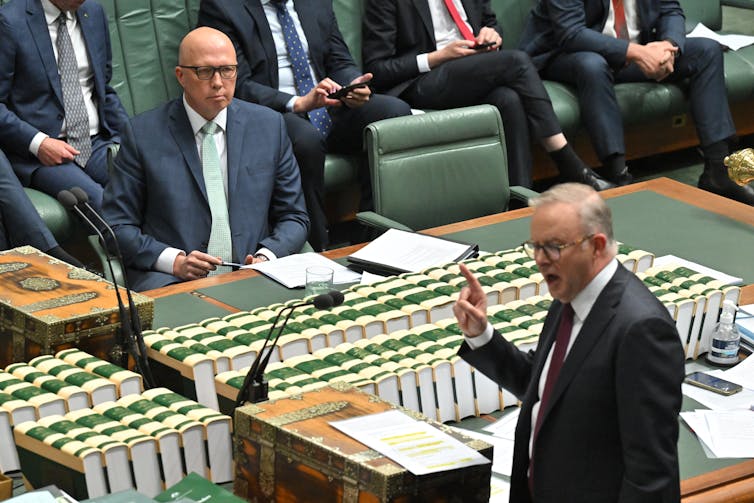Halfway through the 47th federal parliament, we can begin cautiously to gauge the potential historical significance of the “teal” independents.
Contemporaneous analysis, of course, can be problematic but it can also direct attention to emergent dynamics in the way politics operates in Australia. This includes how well voters are represented, politico-cultural shifts and the influence on how laws are made.
The next election will tell us if the 2022 infusion of these independents marked an electoral realignment of longer-term substance or merely a short-term reaction to circumstances. In other words, was it a movement or a moment?
There are three key issues that will help answer this question.
First, many or all of the new crossbench MPs could be defeated, casting their 2022 victories as an aberration driven largely by the unpopularity of the Morrison government rather than by something deep and structural.
Alternatively, they may all be returned, consolidating their respective support locally.
A third outcome builds on the second and would see their ranks swell in 2025, confirming a trend of voter disillusionment with the major parties.
In the second option, Australia would have been politically transformed. In the third, that transformation could be regarded as highly significant, heralding an era of minority governments becoming the most common election result.
The pre-conditions of such a change are already there. The crossbench in the House of Representatives now stands at 16 – a record since the two-party era settled in after the first dozen years of the federation.
Given how finely balanced the political contest appears halfway into this term, a hung parliament looms as more than a mere possibility. Outside of a huge government scandal, a parliamentary majority for the Coalition seems unattainable – that is, without unseating the teals and making other gains. More on that in a moment.
Labor is in a stronger position as the incumbent government, but is hardly ascendant. It confronts a serious cost-of-living crisis that has the potential to cause serious voter unhappiness. While the most recent Newspoll reported a two-party-preferred result of 52-48 in favour of the Albanese government, there is some suggestion the government’s post-election popularity may have topped out and could decline from here.

With a record-low 32.6% primary vote delivering a slender two-seat majority, (a third was gained at the Aston byelection) Labor has little ground to give. The “majors” appear to be managing their prospects in a climate of declining brand loyalty.
For the independents, the opposite may be true. This stark reality is what made the federal election in May 2022 feel like a watershed.
In 2022, teals picked up six seats (Curtin, Goldstein, Kooyong, Mackellar, North Sydney, and Wentworth), adding to two formerly safe Liberal seats (Indi and Warringah)that community independents gained in 2019 and successfully defended in 2022.
It is now plausible to conceive of the “teals” as a loose grouping of eight centrist independents occupying once-safe Liberal seats. Important to that conception also is that all are female and that, on any issue, not all eight automatically align.
Election 2022 was also a watershed because the Australian Greens quadrupled their lower house holdings with three upset wins in Queensland, a state where no “teals” were running.
The future of these Greens seats is an important factor to add into considerations. As independents, the teals cannot ensure legislative change or drive through private members’ bills to a final vote. However, they have proved influential in raising issues, improving legislation and, in some cases, in stiffening government resolve.
This was the case with the government’s emissions reduction legislation. The Greens’ public pressure succeeded in convincing Labor to make its 2030 emissions reduction target of 43% a floor rather than a ceiling. This was a significant change given Labor’s timidity around the electoral politics of emissions.

The government’s National Anti-Corruption Commission – which eventually passed with Coalition support – was also a product in part of the moral leadership from Indi independent Helen Haines. Her private member’s bill ultimately provided the basis of the government’s formula.
Perhaps the biggest macro-political change wrought by the teals has been in the conduct of politics and parliamentary behaviour. This can be difficult to measure, but most observers I’ve spoken to concede the overall tone of parliament has improved in this term, due in no small part to the presence and the articulate advocacy of female MPs, primarily the teals.
Government ministers treat their questions in the House with more respect and civility than was the standard response to crossbenchers under previous governments, most pointedly during the former Morrison period.
Another strength of the teal MPs is their combination of active local representation and clear leadership. This was evident in the referendum. Australia may have rejected the proposed Voice to Parliament by 60% to 40%, but in the 2022 teal seats, where the majority of constituents had been life-long Liberal voters until recently, the Voice registered majority support.
Read more: Voice to Parliament referendum has been heavily defeated nationally and in all states
For these voters, it appears it was the campaigning of the new MP that was persuasive, rather than the Liberal-National Coalition’s bellicose opposition to the proposal.
Among the enlarged group of eight, it was only in the “pre-teal” seat of Indi, held by Haines, that the proposal was rejected. This result is probably explained by the electorate’s status as “rural” according to the Australian Electoral Commission.
Beyond the voter rejection of populist and divisive politics in these inner-urban electorates, the immediate significance of the “yes” vote points to another hurdle for the Liberal Party if it is to reclaim them.
Take the example of Goldstein in Victoria, where independent MP Zoe Daniel ran a vigorous local campaign involving 600 volunteers, 285 Voice-related local events and the specific strategic targeting of some 10,000 homes for doorknocking.
Organised, engaged, locally driven but professional campaigning such as this is beyond even the major parties these days. Along with socio-economic factors, this may be a key reason the teals did better for the Voice than many pro-Voice Labor MPs, whose constituents went decidedly the other way.
More worrying for the Liberals is that the teals have had the benefit now of running a mid-term electorate-wide local campaign in which they could hone their organisational capabilities, connect meaningfully with their constituents outside of an election context, and energise their supporters.
With a well-resourced ground game like that, based on the kind of responsive local representation the established parties more often talk about than actively deliver, the teals may prove supremely hard to dislodge.

